The AMD Radeon R9 Fury Review, Feat. Sapphire & ASUS
by Ryan Smith on July 10, 2015 9:00 AM ESTCompute
Shifting gears, we have our look at compute performance. As compute performance will be more significantly impacted by the reduction in CUs than most other tests, we’re expecting the performance hit for the R9 Fury relative to the R9 Fury X to be more significant here than under our gaming tests.
Starting us off for our look at compute is LuxMark3.0, the latest version of the official benchmark of LuxRender 2.0. LuxRender’s GPU-accelerated rendering mode is an OpenCL based ray tracer that forms a part of the larger LuxRender suite. Ray tracing has become a stronghold for GPUs in recent years as ray tracing maps well to GPU pipelines, allowing artists to render scenes much more quickly than with CPUs alone.

For LuxMark with the R9 Fury X already holding the top spot, the R9 Fury cards easily take the next two spots. One interesting artifact of this is that the R9 Fury’s advantage over the GTX 980 is actually greater than the R9 Fury X’s over the GTX 980 Ti’s, both on an absolute and relative basis. This despite the fact that the R9 Fury is some 13% slower than its fully enabled sibling.
For our second set of compute benchmarks we have CompuBench 1.5, the successor to CLBenchmark. CompuBench offers a wide array of different practical compute workloads, and we’ve decided to focus on face detection, optical flow modeling, and particle simulations.
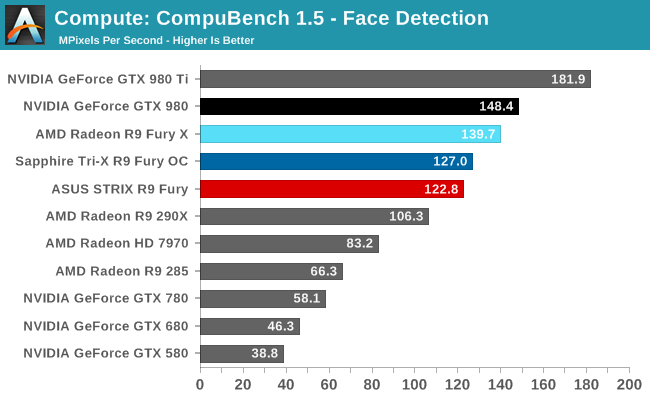
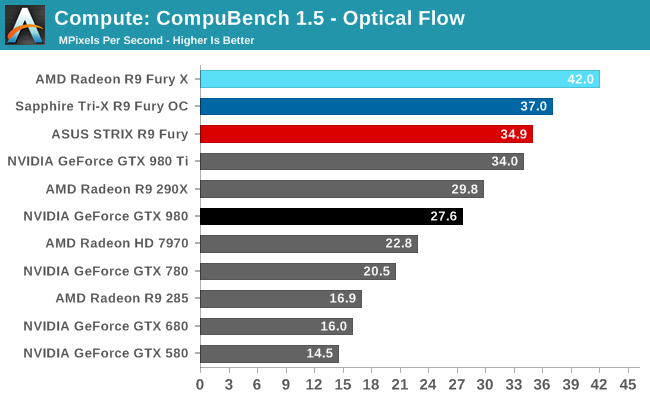

Not unlike LuxMark, tests where the R9 Fury X did well have the R9 Fury doing well too, particularly the optical flow sub-benchmark. The drop-off in that benchmark and face detection is about what we’d expect for losing 1/8th of Fiji’s CUs. On the other hand the particle simulation benchmark is hardly fazed beyond the clockspeed drop, indicating that the bottleneck lies elsewhere.
Our 3rd compute benchmark is Sony Vegas Pro 13, an OpenGL and OpenCL video editing and authoring package. Vegas can use GPUs in a few different ways, the primary uses being to accelerate the video effects and compositing process itself, and in the video encoding step. With video encoding being increasingly offloaded to dedicated DSPs these days we’re focusing on the editing and compositing process, rendering to a low CPU overhead format (XDCAM EX). This specific test comes from Sony, and measures how long it takes to render a video.
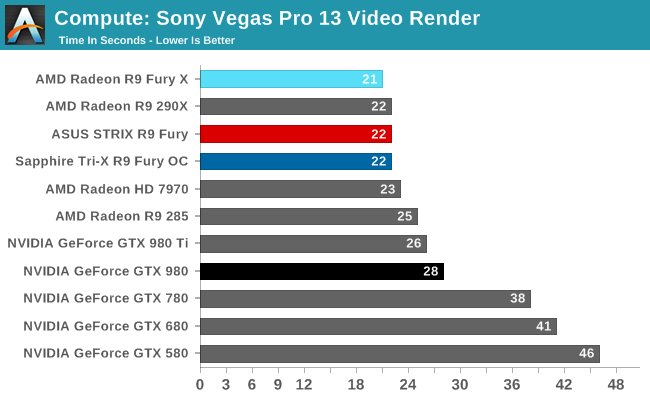
At this point Vegas is becoming increasingly CPU-bound and will be due for replacement. The R9 Fury comes in one second behind the chart-topping R9 Fury X, at 22 seconds.
Moving on, our 4th compute benchmark is FAHBench, the official Folding @ Home benchmark. Folding @ Home is the popular Stanford-backed research and distributed computing initiative that has work distributed to millions of volunteer computers over the internet, each of which is responsible for a tiny slice of a protein folding simulation. FAHBench can test both single precision and double precision floating point performance, with single precision being the most useful metric for most consumer cards due to their low double precision performance. Each precision has two modes, explicit and implicit, the difference being whether water atoms are included in the simulation, which adds quite a bit of work and overhead. This is another OpenCL test, utilizing the OpenCL path for FAHCore 17.
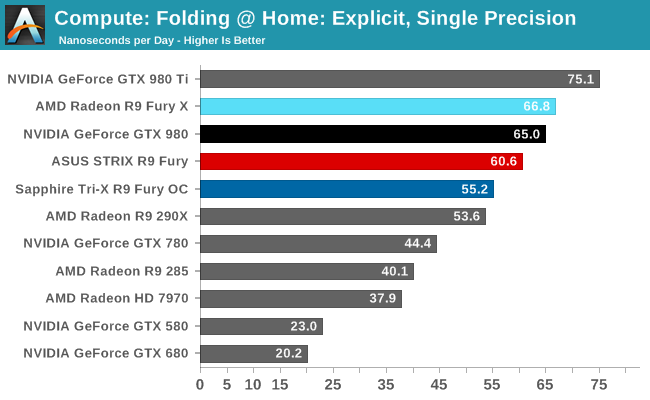
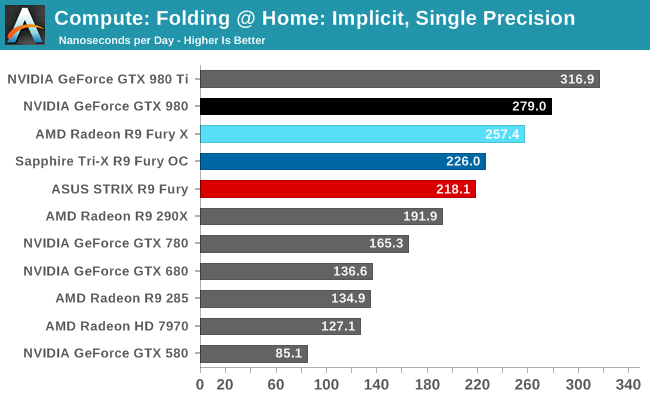

Overall while the R9 Fury doesn’t have to aim quite as high given its weaker GTX 980 competition, FAHBench still stresses the Radeon cards. Under single precision tests the GTX 980 pulls ahead, only surpassed under double precision thanks to NVIDIA’s weaker FP64 performance.
Wrapping things up, our final compute benchmark is an in-house project developed by our very own Dr. Ian Cutress. SystemCompute is our first C++ AMP benchmark, utilizing Microsoft’s simple C++ extensions to allow the easy use of GPU computing in C++ programs. SystemCompute in turn is a collection of benchmarks for several different fundamental compute algorithms, with the final score represented in points. DirectCompute is the compute backend for C++ AMP on Windows, so this forms our other DirectCompute test.
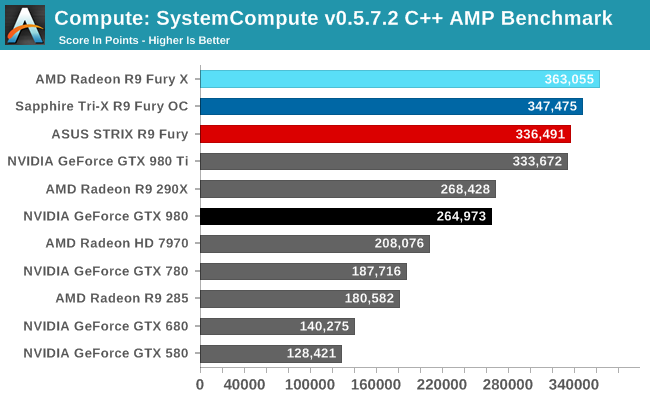
As with our other tests the R9 Fury loses some performance on our C++ AMP benchmark relative to the R9 Fury X, but only around 8%. As a result it’s competitive with the GTX 980 Ti here, blowing well past the GTX 980.










288 Comments
View All Comments
CiccioB - Monday, July 13, 2015 - link
The myth, here again!Let's see these numbers of a miraculous vs crippling driver.
And I mean I WANT NUMBNERS!
Or what you are talking about is just junk you are reporting because you can't elaborate yourself.
Come on, the numbers!!!!!!!!!
FlushedBubblyJock - Thursday, July 16, 2015 - link
So you lied loguerto, but the sad truth is amd bails on it's cards and drivers for them FAR FAR FAR sooner than nvidia does.YEARS SOONER.
Get with it bub.
Count Vladimir - Thursday, July 16, 2015 - link
Hard evidence or gtfo.Roboyt0 - Sunday, July 12, 2015 - link
I am very interested to see how much of a difference ASUS' power delivery system will make for (real) overclocking in general once voltage control is available. If these cards act the same as the 290's did, then AMD's default VRM setup could very likely be more than capable of overclocks in the 25% or more range. I'm basing the 25% or more off of my experience with a half dozen reference based R9 290's, default 947MHz core, that would reach 1200 core clock with ~100mV additional. And if you received a capable card then you could surpass those clocks with more voltage.It appears AMD has followed the EXACT same path they did with the 290 and 290X. The 290X always held a slight lead in performance, but the # of GPU components disabled didn't hinder the 290 as much as anyone thought. This is exactly what we see now with the Fury ~VS~ Fury X...overclock the Fury and it's the better buy. All while the Fury X is there for those who want that little bit of extra performance for the premium, and this time you're getting water cooling! It seems like a pretty good deal to me.
Once 3rd party programmers(not AMD) figure out voltage control for these cards, history will likely repeat itself for AMD. Yes, these will run hotter and use more power than their Nvidia counterparts...I don't see why this is a shock to anyone since this is still 28nm and similar enough to Hawaii...What no one seems to mention is the amount of performance increase compared to Hawaii in the same power/thermal envelope..it's a very significant jump.
Whom in the enthusiast PC world really cares about the additional power draw? We're looking at 60-90W under normal load conditions; Furmark is NOT normal load. Unless electricity where you hail from is that expensive, it isn't actually costing you that much more in the long run. If you're in the market for a ~$550 GPU, then you probably aren't too concerned with buying a good PSU. What the FurMark power draw of the Fury X/Sapphire Fury really tell us is that the reference PCB is capable of handling 385W+ of draw. This should give an idea of what the card can do once we are able to control the voltage.
These cards are enthusiast grade and plenty of those users will remove the included cooler for maximum performance. A full cover waterblock is going to be the key to releasing the full potential of Fury(X) just like it was for 290(X). It is a definite plus to see board partners with solid air cooling solutions out of the gate though...Sapphire's cooling solution fares better in temperature AND noise during FurMark than ASUS' when it's pulling 130W additional power! Way to go Sapphire!
My rant will continue concerning drivers. Nvidia has mature hardware with mature drivers. The fact AMD is keeping up, or winning is some instances, is a solid achievement. Go back to a 290(X) review when their primary competition was a 780 Ti, where the 780 Ti was usually winning. Now, the 390(X), that so many are calling a rebranded POS, easily bests the 780 Ti and competes with GTX 980. Nvidia changed architecture, but AMD is still competitive? Another commenter said it best by saying: "An AMD GPU is like a fine wine, and gets better with age."
This tells me 3 things...
1) Once drivers mature, AMD stands to gain solid performance improvements.
2) Adding voltage control to enable actual overclocking will show the true potential of these cards.
3) Add these two factors together and AMD has another winning product.
Lastly we still have DX12 to factor into all of this. Sure, you can say DX12 is too far away, but in actuality it is not. I know there are those people who MUST HAVE the latest and greatest hardware every time something new comes around every ~9 months. However, there are plenty more of us who wait a few generations of GPUs to upgrade. If DX12 brings even a half of the anticipated performance gains and you're in the market, then purchasing this card now, or in the coming months, will be a solid investment for the coming years.
Peichen - Monday, July 13, 2015 - link
Whatever flats your boat. There are still some people like you that believes FX CPUs are faster than i7s and they are what keeps AMD afloat. The rest of us.... we actually consider everything and go Intel & Nvidia.There are 3 fails in your assumptions:
1. Fiji is a much bigger core tied to 4 HBM modules. OC will likely not be as "smooth" as 290X
2. 60-90W is not just cost in electricity. It is also getting a PSU that will supply the additional draw and more fan(s) and better case to get the heat out. Or suffer the heat and noise. The $15-45 a year in additional electricity bill also means you will be in the red in a couple od years.
3. You assume AMD/ATI driver team is still around and will be around a couple of years in the future.
silverblue - Tuesday, July 14, 2015 - link
3. Unless the driver work has been completely outsourced and there's proof of this happening, I'm not sure you can use this as a "fail".Fiji isn't a brand new version of GCN so I don't expect the huge gains in performance that are being touted, however whatever they do bring to the table should benefit Tonga as well, which will (hopefully) distance itself from Tahiti and perhaps improve sales further down the stack.
Count Vladimir - Thursday, July 16, 2015 - link
Honestly, driver outsourcing might be for the best in case of AMD.Oxford Guy - Wednesday, July 15, 2015 - link
The most electrically efficient 3D computer gaming via an ARM chip, right? Think of all the wasted watts for these big fancy GPUs. Even more efficient are text-based games.FlushedBubblyJock - Thursday, July 16, 2015 - link
You forgot he said spend a hundred and a half on a waterblock...for the amd card, for "full potential"..ROFL - once again the future that never comes is very bright and very expensive.
beck2050 - Monday, July 13, 2015 - link
A bit disingenuous as custom cooled over clocked 980s are the norm these days and easily match or exceed Fury, while running cooler with much less power and can be found cheaper. AMD HAS its work cut out.